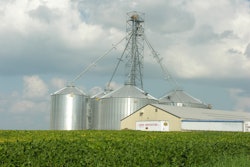The summer of 2012 was one for the books! Record-breaking high temperatures in much of the Corn Belt and the Western Plains coupled with intense drought had a detrimental impact on the corn crop harvested late in the summer and into the fall. The extended dry heat spell —especially the lack of night-time temperature drops — created the perfect breeding ground for mold, leading to the most widespread outbreak of aflatoxin in recent history.
Levels of aflatoxin, a carcinogenic, naturally occurring mold regulated by the Federal Drug Administration (FDA), were so elevated the FDA approved eight states to blend aflatoxin-infected corn into animal feed at well-above normally accepted levels. (See map above for a key of states with confirmed aflatoxin outbreaks in November, and those approved to blend the corn for feed.).
FDA responds
As Leah Wilkinson, director of ingredients and state legislative affairs for the American Feed Industry Association (AFIA), explains, states that demonstrated they had a severe aflatoxin problem were allowed to issue a cooperative agreement with firms that blended aflatoxin into feed. Grain dealers were ordered to file the compliance agreement with their state department of agriculture and the land stewardship before doing any blending.
Provisions in the compliance agreement included:
- Analysis must be performed using approved sampling and analysis protocols and testing procedures outlined by GIPSA
- The results must be provided to the purchaser of the blended corn
- The purchaser must also provide written assurance that the corn will be used for feed consistence with FDA guidance
- The blended corn must be clearly identified and labeled for animal feed use only
- Corn containing aflatoxin levels greater than 500 ppb cannot be blended
The cooperative agreement also established specific aflatoxin levels for different types of livestock. Wilkinson adds, “Most of these state agreements were for a short period of time. The longest went until the end of 2012, and Iowa’s was up at the end of October.”
However, the implications of the aflatoxin outbreak will go on for grain dealers and purchasers for months. “Continued proper testing will give those in the industry the confidence they need to sell their products to the end-user,” Wilkinson says.
As we move into 2013, the role of testing will remain crucial in managing and marketing grain, and protecting your customers and your company.
Testing options abound
As the first provision in each state’s aflatoxin cooperative agreement, clearly testing and analysis is key to regulatory compliance. The Food Safety Modernization Act has also brightened the spotlight on grain testing, and as a result, today’s market offers a variety of products to feed and grain companies.
According to Pat Frasco, director of sales for Neogen, based in Lansing, MI, determining the best testing method for your organization starts by examining how the grain will be used. “Is it for human food or for a feed operation, and what species are they grinding commercial feed for?” are examples Frasco cites. “In some cases you only want to know if it’s below the USDA guidelines, and then a qualitative screening test — which yields a ‘positive’ or ‘negative’ result — might be the best way to decide whether to reject or accept grain.”
On the other hand, situations like the outbreak this summer required the blending of corn at specific levels according to its intended purpose, so a quantitative answer — given in parts per billion (ppb) — was necessary. Frasco says Neogen’s fully quantitative test, Q+ Aflatoxin is ideal for this scenario because it detects up to 150 ppb with only one dilution step, significantly reducing time spent waiting for results.
Test speed is an important factor for feed and grain companies to consider. Sometimes it’s imperative to get results as fast as possible — such as during the harvest rush when grain is incoming truck after truck. But this year, John Jabour, research scientist and mycotoxin analyst at Lawrence, MA-based Charm Sciences, says their customers find as much value in the slower tests as their fastest test offered.
“This year people prefer our 10-minute quantitative ROSA test because it doesn’t require users to run the dilution more than once, which is sometimes needed to get a precise reading with our three-minute test,” Jabour explains. “Our three-minute test, the qualitative AFQ-Fast, is more popular when there isn’t a big problem with aflatoxins and you want to do testing in rapid succession.”
Jim Cary, product manager for VICAM of Milford, MA, agrees there is still a place in the market for tests with a longer incubation period (more than three minutes), and notes years ago all mycotoxin tests took up to an hour to produce results.
“人们希望能够插入into a truck and instantly see if there are toxins present, but that’s not realistic,” Cary says. “We can, however, within about five minutes, give you accurate results anywhere from less than 2 ppb up to 100 ppb with our Afla-V™ test strips and VICAM’s Vertu™ Lateral Flow Reader.”
The old adage “patience is a virtue” rings true with testing now more than ever. Taking the time to properly sample, prepare the sample for analysis and utilize the best testing method for the application will pay off. Managing grain based on toxin levels can help maintain quality during long-term storage and aid in marketing and merchandising.
Storage and marketing considerations
In the high stakes game of quality standards, the marketability of your grain relies on knowing precisely the risks present. Neogen’s Frasco sums it up, “Testing is so important because it allows you to make better merchandising decisions. Identifying specific toxin levels so you can segregate grain at different levels of impact will help you sell one grade to ethanol facilities, another grade to cattle feeders and a different level to pet food manufacturers.”
But it’s not enough to test upon receiving, put it into storage and hope that nothing changes. In-bin mold growth can be as severe a problem as heightened incoming aflatoxin levels.
约翰·l·理查德博士、前总统和首席执行官和铜rrent consultant for Romer Labs of Union, MO, has worked for the USDA-ARS National Animal Disease Center, was a member of the Faculty of Toxicology at Iowa State University and was a leader of the National Center for Agricultural Utilization Research. Richard recalls that aflatoxin was solely considered a storage problem until 1975 when it was found in Iowa corn as it was brought in from the field. Although it’s now known that most toxins take hold before the grain hits the storage bin, Richard warns that aflatoxin levels can rise afterward if poorly managed.
What’s Richard’s advice? “Most importantly, corn should be dried down to 14% moisture level before going into the bin,” he says. “We also know broken kernels are likely to contain more toxins after harvest, so it’s a good idea to screen your corn and get rid of the fines before it goes into storage.”
It’s also wise to regularly test and monitor for changes in toxin levels as grain is transferred out of the bin and shipped out, carried over or blended. Just because it went into the bin at 20 ppb of aflatoxin, doesn’t mean it’s going to come out in that condition next spring or summer.
“Aflatoxin is a living organism and it will grow in storage,” VICAM’s Cary states. “Sometimes it even grows better in storage than in the field, so in addition to safe storage practices, I would recommend testing when it goes in, repeating every three months after that and then when you ship it out to the end-user. Besureyou’re testing before you ship it out."
Keeping bins in top operating order is Frasco’s last bit of advice. “Keep an eye out for bins with airflow issues or malfunctioning temperature cables. Anything that could go wrong in the bin might have an impact on toxin levels.”






















